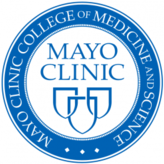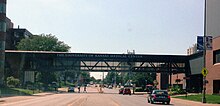
The University of Kansas (KU) is a public research university with its main campus in Lawrence, Kansas. Two branch campuses are in the Kansas City metropolitan area on the Kansas side: the university's medical school and hospital in Kansas City, Kansas, the Edwards Campus in Overland Park. There are also educational and research sites in Garden City, Hays, Leavenworth, Parsons, and Topeka, an agricultural education center in rural north Douglas County, and branches of the medical school in Salina and Wichita. The university is a member of the Association of American Universities and is classified among "R1: Doctoral Universities – Very high research activity".
The Albert Einstein College of Medicine is a private medical school in New York City. Founded in 1953, Einstein operates as an independent degree-granting institution as part of the integrated healthcare Montefiore Health System and also has affiliations with Jacobi Medical Center and Yeshiva University.

Baylor College of Medicine (BCM) is a medical school and research center in Houston, Texas, within the Texas Medical Center, the world's largest medical center. BCM is composed of four academic components: the School of Medicine, the Graduate School of Biomedical Sciences; the School of Health Professions, and the National School of Tropical Medicine.
The University of Texas Southwestern Medical Center is a public academic health science center in Dallas, Texas. With approximately 23,000 employees, more than 3,000 full-time faculty, and nearly 4 million outpatient visits per year, UT Southwestern is the largest medical school in the University of Texas System and the State of Texas.
The University of North Texas Health Science Center is a public academic health science center in Fort Worth, Texas. It is part of the University of North Texas System and was founded in 1966 as the Texas College of Osteopathic Medicine, with its first cohort admitted in 1970. UNT Health Science Center consists of six schools with a total enrollment of 2,329 students (2020–21).
The University of Maryland School of Medicine, located in Baltimore City, Maryland, U.S., is the medical school of the University of Maryland, Baltimore and is affiliated with the University of Maryland Medical Center and Medical System. Established in 1807 as the College of Medicine of Maryland, it is the first public and the fifth oldest medical school in the United States. UMB SOM's campus includes Davidge Hall, which was built in 1812, and is the oldest building in continuous use for medical education in the Northern Hemisphere.
The Medical Scientist Training Programs (MSTPs) are dual-degree training programs that streamline the education towards both clinical and research doctoral degrees. MSTPs are offered by some United States medical schools, who are awarded financial support from the National Institute of General Medical Sciences, a branch of the National Institutes of Health (NIH). The goal of these training programs is to produce physician scientists who can translate laboratory discoveries into effective treatments for patients.
The Doctorate of Medicine and of Philosophy (MD–PhD) is a dual doctoral degree for physician–scientists, combining the professional training of the Doctor of Medicine degree with the research expertise of the Doctor of Philosophy degree; the Ph.D. is the most advanced credential in the United States. Other dual degree programs exist, such as the joint MD–JD degree; both the JD professional degree and the MD are not universally recognized internationally, however. The National Institutes of Health currently provides 50 medical schools with Medical Scientist Training Program grants that support the training of students in MD–PhD programs at these institutions through tuition and stipend allowances. These programs are often competitive, with some admitting as few as two students per academic year. The MCAT score and GPA of MD–PhD matriculants are often higher than MD only matriculants.

The Medical College of Wisconsin (MCW) is a private medical school, pharmacy school, and graduate school of sciences in Milwaukee, Wisconsin. The school was established in 1893 and is the largest research center in eastern Wisconsin. It is associated with Froedtert Hospital as well as Children's Hospital of Wisconsin and houses the Center for Infectious Disease Research There are two additional campuses, one in Green Bay and one in Wausau.

Leonard M. Miller School of Medicine (UMMSM) is the University of Miami's graduate medical school in Miami, Florida. Founded in 1952, it is the oldest medical school in the state of Florida.
The University of Kansas Medical Center, commonly referred to as KU Med or KUMC, is a medical campus for the University of Kansas. KU Med houses the university's schools of medicine, nursing, and health professions, with the primary health science campus in Kansas City, Kansas. Other campuses are located in Wichita and Salina, Kansas, and is connected with the University of Kansas Health System.

The Mayo Clinic College of Medicine and Science (MCCMS), formerly known as Mayo Clinic College of Medicine (MCCM), is a private postgraduate-only research university based in Rochester, Minnesota, United States that trains physicians, scientists, and allied health professionals. The college is part of the Mayo Clinic academic medical center and is accredited by the Higher Learning Commission (HLC). MCCMS consists of five schools that offer M.D., Ph.D., and other degrees, as well as medical residencies, fellowships, and continuing medical education (CME).

The Joan & Sanford I. Weill Medical College of Cornell University is Cornell University's biomedical research unit and medical school in New York City.

The University of Virginia School of Medicine is the graduate medical school of the University of Virginia. The school's facilities are on the University of Virginia grounds adjacent to Academical Village in Charlottesville, Virginia. Founded in 1819 by Thomas Jefferson, UVA SoM is the tenth oldest medical school in the United States. The School of Medicine confers Doctor of Medicine (M.D.) and Doctor of Philosophy (PhD) degrees, and is closely associated with both the University of Virginia Health System and Inova Health System.

The Tri-Institutional MD–PhD Program is an academic program of study based in New York City that was formed by combining earlier MD–PhD programs that had their inceptions in 1972. The current version of the program, which is operated by Weill Cornell Medicine, Rockefeller University, and Memorial Sloan Kettering Cancer Center's Sloan Kettering Institute, was created in 1991.

The University of Wisconsin School of Medicine and Public Health (UWSMPH) is a professional school for the study of medicine and public health at the University of Wisconsin–Madison. It is one of only two medical schools in Wisconsin, along with the Medical College of Wisconsin in Milwaukee, and the only public one.
The University of Colorado School of Medicine is the medical school of the University of Colorado system. It is located at the Anschutz Medical Campus in Aurora, Colorado, one of the four University of Colorado campuses, six miles east of downtown Denver at the junction of Interstate 225 and Colfax Avenue. CU School of Medicine is consistently ranked in the top 10 schools for primary care and in the top 30 schools for research.
Case Western Reserve School of Medicine is the medical school of Case Western Reserve University, a private research university in Cleveland, Ohio. It is the largest biomedical research center in Ohio. CWRU SOM is primarily affiliated with University Hospitals Cleveland Medical Center, Cleveland Clinic, and the MetroHealth System.

The University of Kansas Health System, commonly known as KU Med and formerly known as The University of Kansas Hospital, is a nonprofit, academic medical center located in Kansas City, Kansas, United States, with branch hospitals and education centers in Topeka, Kansas, Great Bend, Kansas, and Lawrence, Kansas. It is the region's only nationally verified Level I Trauma Center. In 1998, it became an independent entity that receives no funding from the state of Kansas. The hospital is affiliated with the University of Kansas Medical Center, which comprises the schools of medicine, nursing and allied health. The University of Kansas Health System combines education, research and patient care. Physicians represent more than 200 specialties.

The Mayo Clinic Alix School of Medicine (MCASOM), formerly known as Mayo Medical School (MMS), is a research-oriented medical school based in Rochester, Minnesota, with additional campuses in Arizona and Florida. MCASOM is a school within the Mayo Clinic College of Medicine and Science (MCCMS), the education division of the Mayo Clinic. It grants the Doctor of Medicine (M.D.) degree, accredited by the Higher Learning Commission (HLC) and the Liaison Committee on Medical Education (LCME). In November 2018, the school was renamed in honor of a $200 million donation from businessman Jay Alix.













